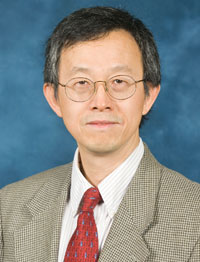
Jwo Pan, Professor of Mechanical Engineering, and his graduate students have been selected to receive the SAE Arch T. Colwell Merit Award for their SAE paper, which focuses on friction spot welding and its failure mode. The Society of Automotive Engineers considers the research as a step towards improving the future generation of lightweight vehicles.
Pan’s four students, Seung-Hoon Hong, Kulthida Sripichai, Chia-Siung Yu, and Katherine Avery helped to co-author his paper entitled, “Failure Modes of Friction Stir Spot Welds in Lap-Shear Specimens of Dissimilar Advanced High Strength Steels under Quasi-Static and Cyclic Loading Conditions.”
The paper focuses on the failure modes of friction stir spot welds between dissimilar high strength dual phase steel (DP780GA) and hot stamped boron steel (HSBS) sheets. Pan explained that frictions spot welding is a relatively new method used to join solid materials, such as steel sheets.
“Advanced high strength steels are for the future generation of lightweight vehicles,” Pan said. “These different high strength steels must be joined together to make multi-material lightweight vehicles.”
Friction spot welding, according to the research paper, is the most commonly used method for joining steel sheets. But, the process is less effective for other metals, such as aluminum. The paper’s introduction explains the team’s intention to test the new “friction stir spot welding” developed by Mazda Motor Corporation and Kawasaki Heavy Industry, that may be more effective in joining aluminum sheets.
The research was a collaboration of two separate facilities: the University’s Structural Durability Lab, headed by Pan, and the Oak Ridge National Laboratory. The ORNL is the U.S. Department of Energy’s largest laboratory and accepts about 3000 guest researchers each year. The Lightweight Materials Program of Department of Energy supported the research project.
According to the U.S. Department of Energy, research on lightweight materials is pertinent to lowering the cost of more energy-efficient vehicles by maximizing fuel economy and increasing their ability to be recycled. Such innovations are important in the context of our more energy-conscious society.
Graduate student Seung-Hoon Hong led the research team and partook in the research done both on campus and at the ORNL. After defining criteria for optimum welding conditions, he travelled to Oak Ridge, Tennessee to create the actual welds at ORNL. Upon his return to the University, Hong performed quasi-static and fatigue testing of the welds.
Kulthida Sripichai, another graduate student who co-authored the paper conducted weld-failure analyses. Co-authors, Chia-Siung Yu and Katherine Avery assisted in the fatigue testing of the welds.
Pan emphasized each graduate student’s specific place within the research, along with their ability to benefit from one another’s different strengths.
“The graduate students worked very well with each other for the research project that requires collaborative effort from students with different backgrounds and skills,” Pan said.
The official award will be presented to the group at the 2014 SAE World Congress, held April 8th- 10th in Detroit. During the event, distinguished members of the engineering community will address current challenges within the automotive industry, while collaborating with other researchers to create solutions.
